|
H.J. Brow, 1923 (Source: Find A Grave)
 |
Harold Brow landed twice at Tucson. His first landing was on Monday, August 19, 1929. He landed solo in an unidentified Boeing F2B. Based at San Diego, CA aboard the U.S.S. Saratoga, he arrived amidst nineteen other naval aviators, each signed into the Register on the middle third of page 112. Other than the first six who signed their own names, the rest, including Brow, were entered by an unknown hand all at once. Please direct your browser to the link and review page 112. There you'll see that signers Chourre through Wick comprise the group of twenty. They all remained overnight at Tucson, departing the morning of the 20th for El Paso, TX. Photograph, right, from his memorial at Find A Grave. Follow the link to see other photographs, as well as a brief biography.
What were twenty Navy pilots doing at Tucson all at once? They were on a grand cross-country flight headed from San Diego to Cleveland, OH and back to participate in the National Air Races (NAR) held August 24th-September 2nd at Cleveland that year. Lt. Cdr. Homer Wick was commanding officer of Squadron No. 1 based on the Saratoga.
Wick brought his entire squadron through Tucson on behalf of the NAR. During the 1920s and 1930s, the Navy ordered numerous activities by its personnel, ships and airplanes to build confidence in the naval force among the U.S. citizenry, to provide real-life training for personnel, as well as to encourage recruitment.
Brow's job in the group was to participate in event No. 21 of the NAR, the Navy Pursuit Race. It took place on August 30th and covered 100 miles in ten, 10-mile laps. According to the Aircraft Yearbook for 1930, sixteen navy pilots competed, but Brow was disqualified because of fouled pylons. Please direct your browser to Wick's page to see a tabulation and identification of all the men in his squadron.
His second landing was about a month after his first, on Monday, September 23, 1929. This time he flew a Sikorsky XPS-2, A-8285. He carried two passengers, a captain Orr and AMM Thoburn. Based at San Diego, CA, they were westbound from El Paso, TX to Phoenix, AZ. No hints were recorded in the Register to suggest the reason for their flight.
Brow had a history with the Navy before his trip to the NAR. Below is a column from the 1922 volume of "Who's Who in American Aeronautics" that summarizes his career to that point. We learn his birth date of December 30, 1894, and that he participated in the bombing exercises motivated by General Billy Mitchell's belief that bombers could sink navy ships.
1922 "Who's Who in American Aeronautics" (Source: Woodling)
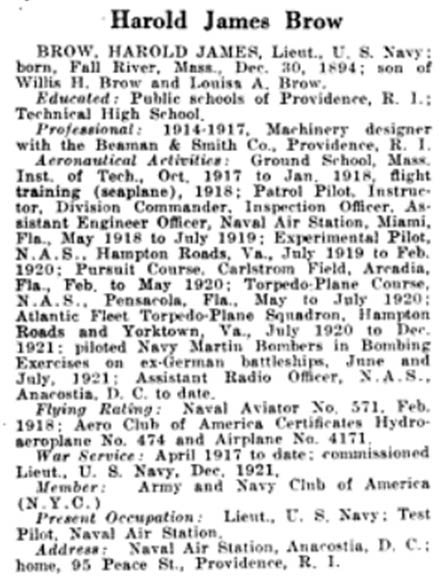 |
Below, from the San Diego Aerospace Museum Flickr Stream (SDAM), is an undated image of Brow. The date is probably during his seaplane training mentioned in the article above.
H.J. Brow Seated on a Seaplane, Date & Location Unknown (Source: SDAM)
 |
The New York Times, November 7, 1923 (Source: NYT)
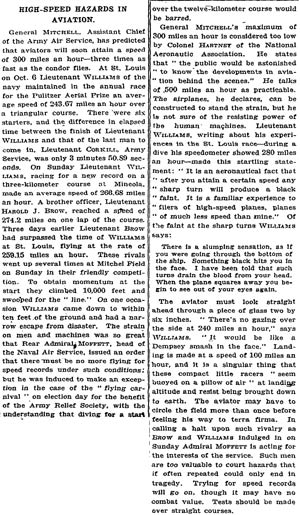 |
1922 Pulitzer Bronze Won By H.J. Brow (Source: NNAH)
 |
During the early 1920s, Brow had several years of success with Navy speed planes and served as one of the pilots to set records with the famous Curtiss Racers of the era. On October 14, 1922, then Lieutenants Harold J. Brow and Alford J. Williams (not a Register pilot), flying CR-2 and CR-1 Curtiss Racers with Curtiss D-12 engines, finished third and fourth in the Pulitzer Trophy Race at Detroit, MI, making speeds of 193 and 187 MPH, respectively. Above, right is Brow's third place medal for the event. Read more about the Pulitzers at the link.
The next year, on November 2, 1923, Brow (see his photograph from this year at top of page), flying an R2C-1 equipped with a Curtiss D-12 engine, established a world speed record at Mitchel Field, Long Island, NY, averaging 259 MPH. He also placed second in the Pulitzer Race at St. Louis, MO.Then, on November 4th, Williams, also flying an R2C-1 raised the record to 266.59 MPH.
This exchange of speed records was so exhilarating that the Times of November 7th, above left, carried quotes by Williams and Brow, and by both Army and Navy flag officers to limit the speeds of aircraft during such events. What was described as a "friendly competition," actually had some touch and go moments when Williams misjudged the ground and came within 10 feet of it out of a dive at high speed. This brought Rear Admiral Moffett, head of the Naval Air Service at the time, to issue an order that there must be no more flying for speed records under such conditions (diving to pick up speed). To my knowledge this mandate was not adhered to.
The New York Times, February 9, 1930 (Source: NYT)
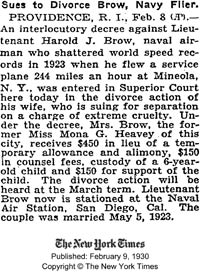 |
As well, Army General Mitchell, Assistant Chief of the Army Air Service, suggested a maximum speed of 300 MPH not be exceeded. Williams cites the hazards of blackouts in high-G turns, a phenomenon familiar to pilots, but seemingly not to the general public. Note the mention of Register pilot John Corkville in the first column. He was a test pilot at Wright Field, Dayton, OH.
Some of the excitement of that day was also captured in an article from The New York Times of November 5, 1923 as well as articles in other syndicated newspapers around the country. Another article from the November 11th Times (PDF; 218kB) is at the link. It contains extensive quotes by Brow (in the second column) about his experiences during racing and setting his records. It was a heady time for Navy air race wins and records. An excellent history of the Navy's Golden Age of air racing during the 1920s, published in the December, 1969 Naval Aviation News, is at the link.
It was a heady time for Brow also, who was married on May 5, 1923. The article, right, from The New York Times of February 9, 1930 cites the date, as well as announces the dissolution of that marriage seven years later.
During the 1920s, and still early in his career, Brow is often credited with making the first night landing on an aircraft carrier. However, on April 8, 1925, Lieutenant John D. Price, piloting a VF-1, made a night landing on the U.S.S. Langley, at sea off San Diego, CA, and was followed on board by Lieutenants Delbert L. Conley, Aldolphus W. Gorton and Rossmore D. Lyon. This REFERENCE, page 61 states, "Except for an accidental landing on the night of 5 February when Lieutenant Harold J. Brow stalled while practicing night approaches, these were the first night landings made on board a U.S. carrier." It seems Brow's "first" landing was actually an "accidental" landing and therefore not logged in the record book.
The New York Times, October 3, 1940 (Source: NYT)
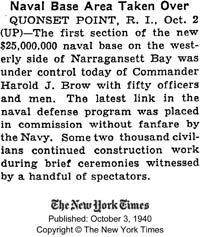 |
H.J. Brow, 1943-44 (Source: USNM)
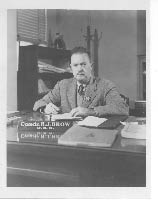 |
I have little information about Brow regarding his duties during the 1930s. As WWII approached, he was assigned as commander of the newly constructed Quonset Point, RI naval base. At right, The New York Times of October 3, 1940 reports his assignment.
At left, from his own collection of photographs housed at the U.S. Naval Museum (USNM), Pensacola, FL, is a portrait of Brow dated 1943-44. The caption at the Museum reads, "Commander Harold J. Brow pictured at his desk while serving as a Navy technical representative at United Aircraft Corporation, 1943-1944."
H.J. Brow, 1944-45 (Source: USNM)
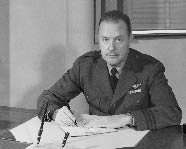 |
At right, again from his collection at USNM, is a photograph from his next assignment. His caption reads, "Commander Harold J. Brow pictured in his aviation green uniform while serving as commanding officer of Naval Air Station (NAS) Olathe, Kansas, 1944-1945.
Brow's Son's Wedding, September, 1945 (Source: NYT)
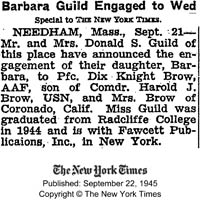 |
With the war's end, we find Brow's son in the news on on the occasion of his engagement. From the Times of September 22, 1945, left, we learn of the ceremony. This type of announcement, as well as the ensuing weddings and births multiplied by the hundreds of thousands, would result in the "Baby Boomer" generation that would do so much to change the country's demographics, consumer patterns and politics in a few short decades.
Below is Brow's obituary from an undated and unsourced news article. Brow died Apr. 18, 1982. We learn from it that he entered naval aviation by an alternate route. Most of his peers that landed with him that day in Tucson were graduates of the U.S. Naval Academy. Brow was part of a group of officers that attended ground school at various universities around the country (MIT in his case), followed by flight training at Pensacola, FL. Please direct your browser to fellow officer Charles Ironmonger's page for an explanation of the formalized mechanism of that route to Naval Aviator. He enjoyed a good, long retirement from the Navy, probably allowing him much time to spend with his grandchildren.
"A native of Fall River, MA, Harold James Brow served in the Rhode Island National Guard
during the period 1913-1914, and entered the Navy on 6 April 1917. After training at the
Massachusetts Institute of Technology and NAS Pensacola, FL, he received his wings as Naval
Aviator Number 571 on 23 March 1918. Following service at NAS Hampton Roads, VA, and NAS
Miami, FL, he led the Atlantic Fleet Torpedo Squadron and during 1921 commanded a squadron of
Navy Martin MB bombers during bombing tests off the Virginia coast against captured German
naval vessels. As a test pilot Brow competed in the National Air Races and Pulitzer Trophy
Race and established a world's speed record in 1923. A pioneer carrier pilot on board USS
Langley (CV 1), he later commanded Fighting Plane Squadron One on board USS Saratoga (CV 3),
as well as VT-2B, VP-4F, and VS-10S. During World War II he served at NAS Alameda, CA, and
NAS Quonset Point, RI. He retired from the Navy in 1947 and died in 1982."
|
As in the Register, Brow's name is sometimes interpreted as "Brown" by journalists and others. Please allow for that if you perform online searches for him. An excellent set of photographs of Brow and his wife later in age, as well as a short biography that perpetuates his first night carrier landing credit, is at the link to Find A Grave.
---o0o---
THIS PAGE UPLOADED: 02/22/12 REVISED:
|











